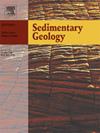亚马逊河石英颗粒微量元素和OH含量:在物源分析中的潜在应用
IF 2.9
2区 地球科学
Q1 GEOLOGY
引用次数: 0
摘要
利用红外光谱(ftir)和二次离子质谱技术对亚马逊河及其5条主要支流沉积物中的石英颗粒进行了分析,以评价其在物源分析中的潜力。此外,在相同的样品中进行了重矿物分析,以支持沉积物区分和物源解释。源头排水安第斯山脉的支流携带的石英颗粒中平均缺陷水含量(Solimões河8.8 wt ppm,马德拉河7.2 wt ppm)高于专门排水克拉通地区的支流(新古河6.5 wt ppm, Tapajós河4.6 wt ppm,内格罗河4.7 wt ppm);一个亚马逊河主干样本的值与安第斯信号的流行率(7.7 wt ppm)处于中间水平。平均缺陷含水率与富缺陷含水率(>;从Solimões、马德拉河和亚马逊河的30 - 40%到Tapajós和Negro河的10 - 20%不等。平均分子-水信号表现出比oh缺陷信号更清晰的对比。克拉通支流(内格罗河、Tapajós河和兴古河)颗粒的分子水信号明显弱于安第斯支流(Solimões河和马德拉河)颗粒;亚马逊主河中颗粒的信号略弱于后者,反映了亚马逊主河样品中Solimões和Negro河流石英的混合物。相比之下,样品之间的微量元素浓度广泛重叠,阻止了对石英颗粒来源的任何强有力的区分。微量金属在所有样品中Li和Al之间表现出良好的相关性;在内格罗、新古和亚马逊河砂中观察到Al和Ti的弱相关性(指示火成岩成因),而在Solimões、马德拉和Tapajós砂中则没有。在Tapajós河和亚马逊河主干样品中硼与Li相关,在马德拉河和Tapajós样品中硼与Al相关。主要产自安第斯山脉的Solimões河砂中的重矿物主要为角闪石、绿帘石、斜辉石和超长辉石,马德拉河砂中的重矿物主要为红柱石、角闪石和绿帘石。克拉通支流提供耐用的碧玺和锆石与红柱石(内格罗河)或橄榄石和黄玉(Tapajós河)。安第斯山脉石英颗粒中OH缺陷和分子水的含量高于克拉通地区的石英颗粒,表明这一性质可以为鉴别石英颗粒的来源提供有用的补充信息,这是物源分析中最棘手的任务之一。本文章由计算机程序翻译,如有差异,请以英文原文为准。
Trace element and OH content of quartz grains in the Amazon river: Potential application in provenance analysis
Quartz grains in sediment carried by the Amazon River and five of its major tributaries were analyzed by FTIR-spectroscopy and secondary ion mass spectrometry to evaluate their potential for provenance analysis. Additionally, heavy mineral analysis was performed in the same samples to support sediment discrimination and provenance interpretation. Average defect water contents in quartz grains carried by branches with headwaters draining the Andes are higher (Solimões River 8.8 wt ppm, Madeira River 7.2 wt ppm) than in branches exclusively draining cratonic areas (Xingu River 6.5 wt ppm, Tapajós River 4.6 wt ppm, Negro River 4.7 wt ppm); values in one Amazon mainstem sample are intermediate with prevalence of the Andean signal (7.7 wt ppm). The average defect water content correlates to the fraction of grains that are defect-water rich (> 10 wt ppm), ranging from 30 to 40 % for the Solimões, Madeira, and Amazon Rivers down to 10–20 % for the Tapajós and Negro Rivers. The average molecular-water signal exhibits a much clearer contrast than the OH-defect signal. Grains from cratonic tributaries (Negro, Tapajós and Xingu rivers) exhibit significantly weaker molecular water signals than grains from Andean tributaries (Solimões and Madeira rivers); slightly weaker than the latter is the signal from grains in the Amazon mainstem, reflecting a mixture of Solimões and Negro rivers quartz in the Amazon mainstem sample.
In contrast, trace-element concentrations widely overlap among samples, preventing any robust discrimination about the sources of quartz grains. Trace metals show a fair correlation between Li and Al in all samples; a weak correlation between Al and Ti (indicative of igneous origin) was observed in Negro, Xingu and Amazon River sands, but not in Solimões, Madeira and Tapajós sands. Boron correlates with Li in Tapajós river and Amazon mainstem samples and with Al in Madeira and Tapajós samples.
Heavy-minerals are mostly amphibole, epidote, augitic clinopyroxene and hypersthene in Solimões River sands largely derived from the Andes, and andalusite, amphibole and epidote in Madeira River sands. Cratonic tributaries contribute durable tourmaline and zircon with andalusite (Negro River) or staurolite and topaz (Tapajós River).
The higher content of OH defects and molecular water in quartz grains derived from the Andes than in those from cratonic areas indicates that this property can provide useful complementary information to discriminate the source of quartz grains, one of the thorniest tasks in provenance analysis.
求助全文
通过发布文献求助,成功后即可免费获取论文全文。
去求助
来源期刊

Sedimentary Geology
地学-地质学
CiteScore
5.10
自引率
7.10%
发文量
133
审稿时长
32 days
期刊介绍:
Sedimentary Geology is a journal that rapidly publishes high quality, original research and review papers that cover all aspects of sediments and sedimentary rocks at all spatial and temporal scales. Submitted papers must make a significant contribution to the field of study and must place the research in a broad context, so that it is of interest to the diverse, international readership of the journal. Papers that are largely descriptive in nature, of limited scope or local geographical significance, or based on limited data will not be considered for publication.
 求助内容:
求助内容: 应助结果提醒方式:
应助结果提醒方式:


